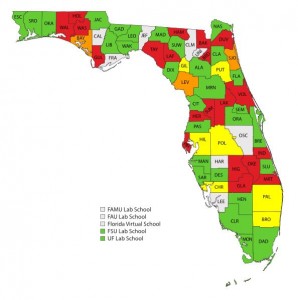State Website Measures Whether Florida Schools Are Ready For New Standards And Testing

Florida Readiness Gauge / Florida Department of Education
This map shows how school districts are reporting broadband Internet access. Green districts mean at least 75 percent of schools meet standards. Red districts mean less than 25 percent of schools meet standards.
The State Board of Education will get an update next week on Florida’s next education standards, the Common Core State Standards.
The meeting will include information about the technology needed to implement the new assessments that are scheduled to begin in early 2015.
Florida is among a group of states developing the PARCC assessments, or Partnership for Assessment of Readiness for College and Careers.
The PARCC tests will be given online.
The main concern is technology and whether the proper equipment will be in place for testing in all 67 districts when the 2014-15 school year begins.
The Florida Department of Education has come up with a readiness gauge to measure each district’s progress toward meeting Common Core and digital learning deadlines.
A map of Florida gives each district a color based on readiness.
Most districts at the elementary, middle, and high school level are shaded green for Common Core readiness.
- Green = Ready with evidence to support
- Yellow = Ready with no evidence reported
- Red = Not ready
- Gray = Not reported
Education Commissioner Tony Bennett says the Common Core roll out is on schedule despite his assertion that a ‘Plan B’ may be necessary in case of technical delays.
The Department of Education says no ‘Plan B’ has been determined.
The gauge shows mixed results for the districts as they try to modernize technology and utilize more digital learning.
Digital learning indicators:
- Student Computer Ratio – Percent of schools that meet or exceed the minimum standard student to computer ratio. The standard is 2.75 students to 1 computer for 2012-2013.
- CBT Success – Computer Based Testing: Percent of schools that have no issues for current FCAT and End of Course exams
- BYOD Policy – Percent of schools with bring your own device policies
- Broadband Speed – Percent of schools that meet or exceed the minimum K-12 broadband bandwidth standard
- High Speed Wireless – Percent of schools that support high-speed wireless internet
- Home Internet Access – Percent of students that have internet access at home
Patricia Levesque, Executive Director of the Foundation for Florida’s Future, wants every student learning daily with a laptop or other digital device with an internet connection.
“In my son’s classroom, there’s one computer and it sits off to the side and it’s used as a reward,” Levesque said. “When students have done really well, they get two or three minutes that they get to spend on the computer. But that’s not the way it should be.”
